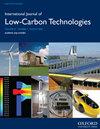竖管爬升膜海水淡化系统的热优化研究
IF 2.3
4区 工程技术
Q3 ENERGY & FUELS
引用次数: 0
摘要
基于夹点理论和能量梯级利用原理,分析了热蒸汽压缩与不同预热配置相结合的多效船用垂直管爬升膜海水淡化系统的性能。建立数学模型进行热力学模拟,考虑沸点标高和压降造成的各种热力学损失,利用有效换热温差和热侧温差分析加热蒸汽温度、最终效果蒸发温度、浓缩比对获得输出比(GOR)等热工性能的影响。不同预热配置的比传热面积。结果表明,内部平均有效换热温差决定了多效精馏系统的性能。而对于平均有效换热温度相近的系统,热侧温差为控制参数。能量梯级利用原理在多效蒸馏热力学系统中显示出控制属性,GOR的提高主要是利用了预热过程中加热蒸汽的二次能和余能。本文章由计算机程序翻译,如有差异,请以英文原文为准。
Thermal optimization research of vertical tube climbing film desalination system
Based on the pinch theory and energy cascade utilization principle, the performance of a multi effect shipboard vertical tube climbing film desalination system combined thermal vapour compression with different preheating configuration has been analyzed. The mathematical model is established for thermodynamic simulation, in which various thermodynamic losses caused by boiling point elevation and pressure drop are considered, and the effective heat transfer temperature difference and temperature difference of hot side are used to analyze the influences of heating steam temperature, final effect evaporation temperature, and concentration ratio on thermal performance including gained output ratio (GOR), specific heat transfer area for different preheating configuration. The results show that the internal average effective heat transfer temperature difference determines characteristics of multi-effect distillation system. While for system with similar average effective heat transfer temperature, the temperature difference of hot side is the controlling parameter. And the energy cascade utilization principle shows the controlling attribute in multi-effect distillation thermodynamic system, as GOR is improved mainly due to utilization of the secondary energy and residual energy of the heating steam for preheating process.
求助全文
通过发布文献求助,成功后即可免费获取论文全文。
去求助
来源期刊

International Journal of Low-carbon Technologies
Engineering-Architecture
CiteScore
4.30
自引率
4.30%
发文量
106
审稿时长
27 weeks
期刊介绍:
The International Journal of Low-Carbon Technologies is a quarterly publication concerned with the challenge of climate change and its effects on the built environment and sustainability. The Journal publishes original, quality research papers on issues of climate change, sustainable development and the built environment related to architecture, building services engineering, civil engineering, building engineering, urban design and other disciplines. It features in-depth articles, technical notes, review papers, book reviews and special issues devoted to international conferences. The journal encourages submissions related to interdisciplinary research in the built environment. The journal is available in paper and electronic formats. All articles are peer-reviewed by leading experts in the field.
 求助内容:
求助内容: 应助结果提醒方式:
应助结果提醒方式:


